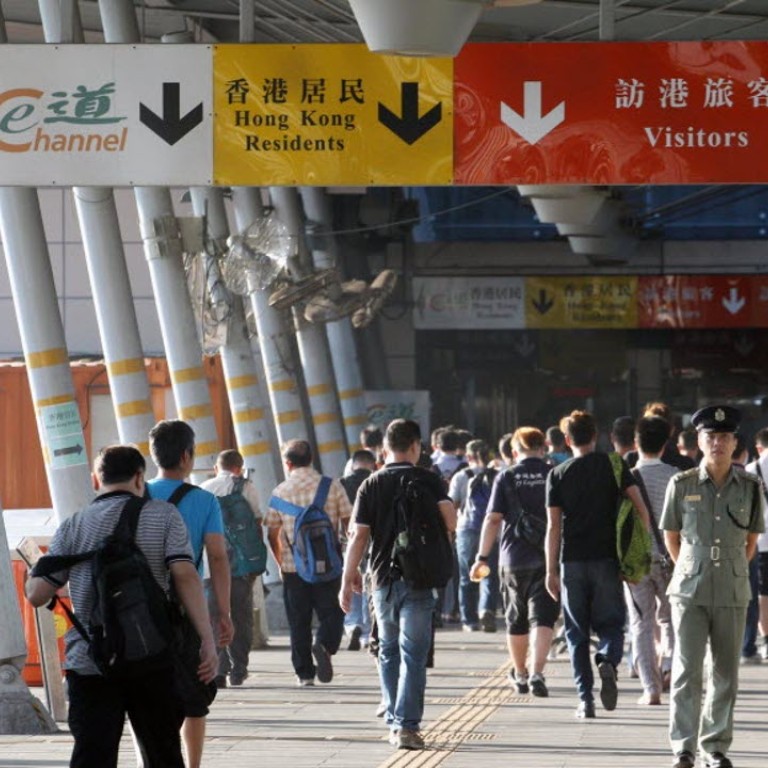
Fewer mainland Chinese settle in Hong Kong, leading to cut in population growth projection
Census official predicts that only 100 will take advantage of daily quota of 150, prompting a cut in the population growth estimate
Fewer mainlanders have been settling in Hong Kong under the one-way permit system, as arrivals fall below the daily quota, prompting census officials to warn of slower population growth.
Officials forecast that only two-thirds of the daily quota of 150 one-way visas would be used up in the medium to long-term.
The decline in recent years led the Census and Statistics Department to cut its annual population growth projection from 0.6 per cent in its 2011 estimate to 0.2 per cent in the latest report based on last year's figures.
READ MORE: Growth spurt: report shows 879,000 Hong Kong residents now from mainland China
In the 2011 estimate, the department assumed the daily inflow of one-way permit holders would continue to be 150.
Acting Commissioner for Census and Statistics Stephen Leung Kwan-chi told lawmakers yesterday that the lower take-up rate since 2013 could weaken further, with mainlanders expected to use only 100 out of the 150 daily permits available.

Hong Kong has one of the world’s lowest birth rates at 8.6 per 1,000 people last year, down from 13.5 in 2011, according to government statistics. The inflow of one-way permit holders is therefore crucial in adding to the overall population.
Under the scheme, launched in 1997 largely to allow family reunion, up to 150 permits are available for mainland applicants every day. In the past, many were mainland mothers seeking to join their children and husbands in Hong Kong.
According to official figures, the use of the daily quota – which dipped in 2007 and 2008 – reached a peak in 2012, with an average of 149 mainlanders admitted into the city every day. However, that number has been slipping since then, with 123 people in 2013 and 111 last year.
However, a paper released to lawmakers said: “The revised assumption should in no way be construed as any intention to change the [one-way permit] scheme”, adding the mainland authorities had no plan to revise the existing quota.
“Given the prevalence of cross-boundary marriages which have made up almost 40 per cent of locally registered marriages, there is a continued need for the scheme to enable separated spouses and their children born on the mainland to come to Hong Kong for family reunion,” said the paper.
A leading social policy academic and a social worker said better living standards on the mainland had led to fewer applications for one-way permits, while recent anti-mainland sentiment in the city might also have had an impact.
READ MORE: Mainland Chinese immigrants to Hong Kong risk living ‘in own little worlds’, researcher says
“The difference in living standards between Hong Kong and the mainland has narrowed significantly over the years,” said Chou Kee-lee, head of the Department of Asian and Policy Studies at the Hong Kong Institute of Education.
“There may be more job opportunities on the mainland. [Potential applicants] have fewer incentives to move to Hong Kong,” the academic added.
Veteran social worker Sze Lai-shan of the Society for Community Organisation said: “If an applicant has a job and already made it to the middle class, he or she may choose to stay on the mainland, even though the application is approved.”
Sze noted the fact that fewer people were eligible to apply, as priority was given to young children to join their parents living in Hong Kong and most of the qualified ones were already here. This had contributed to fewer new arrivals, she said.
Sze urged the government to allocate unused quotas to other mainlanders in need, such as widowed single parents who needed to take care of their children living in Hong Kong.
Chou said the scheme remained effective in providing much-needed new members for the city’s labour force. “Hong Kong’s birth rate has stayed at a low level and the population is ageing. People moving to the city through the one-way permit scheme are able to make up for the increasingly severe labour shortfall,” he said.


